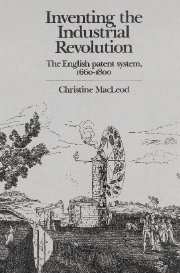Book contents
- Frontmatter
- Contents
- List of tables and figure
- Acknowledgements
- List of abbreviations
- Notes on style
- Introduction
- 1 Patents 1550–1660: law, policy and controversy
- 2 The later-Stuart patent grant – an instrument of policy?
- 3 The development of the patent system, 1660–1800
- 4 The judiciary and the enforcement of patent rights
- 5 The decision to patent
- 6 Invention outside the patent system
- 7 Patents in a capitalist economy
- 8 The long-term rise in patents
- 9 The goals of invention
- 10 Patents: criticisms and alternatives
- 11 A new concept of invention
- Notes
- Bibliography
- Index
3 - The development of the patent system, 1660–1800
Published online by Cambridge University Press: 28 October 2009
- Frontmatter
- Contents
- List of tables and figure
- Acknowledgements
- List of abbreviations
- Notes on style
- Introduction
- 1 Patents 1550–1660: law, policy and controversy
- 2 The later-Stuart patent grant – an instrument of policy?
- 3 The development of the patent system, 1660–1800
- 4 The judiciary and the enforcement of patent rights
- 5 The decision to patent
- 6 Invention outside the patent system
- 7 Patents in a capitalist economy
- 8 The long-term rise in patents
- 9 The goals of invention
- 10 Patents: criticisms and alternatives
- 11 A new concept of invention
- Notes
- Bibliography
- Index
Summary
The routine management of the English patent system was left to government officials acting within the wide scope allowed by the common law and, after 1624, by the Statute of Monopolies. No statutory changes interrupted their habits of administration before the Act of 1852 (15 & 16 Viet. c. 83), yet 1660–1800 was a period of considerable discontinuity and development. Indeed, to find a watershed for the patent system we should look not to 1640–60, when it was in abeyance, but to the quieter years, 1700–20. The Restoration patent system embodied no new administrative features and, while shorn of its worst abuses, it was still a creature of courtly circles. Change came in with the new century: there was an ebb in patenting and, largely in reaction to speculative financial booms which exploited and discredited patents for invention in 1691–4 and 1717–20, new restrictions were placed on them. Partly as a result of these controls, and partly because of new market forces and opportunities, patents ceased to be the perquisite of courtiers, office-holders and immigrant tradesmen. They began to assume a more distinct and recognizable form as instruments of protection and competition among native inventors and entrepreneurs and, increasingly, if hesitantly, to leave London for the provinces.
ADMINISTRATION AND SCRUTINY OF PATENTS
The route to a patent was laid down by the Clerks Act of 1535, which applied to all grants of the crown under the great seal and was intended, as stated ingenuously in its preamble, to finance unsalaried government clerks. To achieve this end it made the journey from petition to enrolment unnecessarily lengthy and tortuous.
- Type
- Chapter
- Information
- Inventing the Industrial RevolutionThe English Patent System, 1660–1800, pp. 40 - 57Publisher: Cambridge University PressPrint publication year: 1988
- 1
- Cited by



